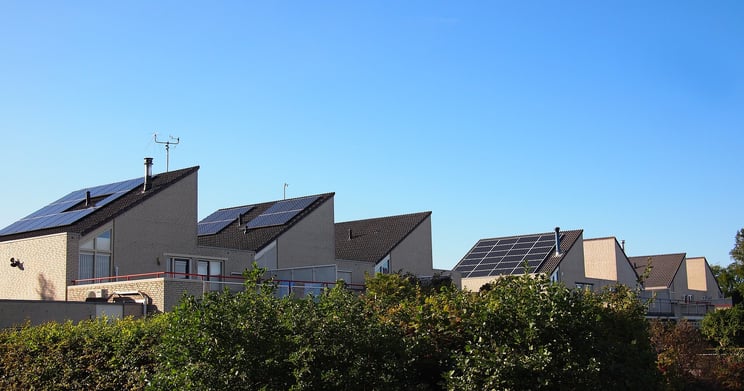It’s important to do your research when planning your solar system, but the sea of technical terms can soon become overwhelming. Let’s address some of those you may come across when comparing types of solar panel - and see how those types stack up.
Solar PV vs solar thermal
The first thing to distinguish between are solar photovoltaic (PV) panels, which generate electricity, and solar thermal panels, which generate heat. PV systems are made from materials which form an electric field, generating power in sunlight and sending this to electrical appliances in the home or the national grid. Thermal systems pump round liquid that heats up under the sun’s rays, and in turn warms your hot water tank.
You can read our thermal vs PV page for more details, but at Spirit we recommend and install solar PV. Now let’s take a look at the various types of photovoltaic modules.
Crystalline and thin film panels
There are three main types of solar PV used commercially: monocrystalline, polycrystalline and thin film.
|
Panel type |
Relative cost |
Efficiency |
Colour |
Lifespan |
|
Monocrystalline |
Expensive |
16-23% |
Uniform dark blue/black |
25+ years |
|
Polycrystalline |
Moderate |
15-17% |
Speckled blue |
25+ years |
|
Thin film |
Cheap |
12-14% |
Uniform, various colours |
10-15+ years |
Monocrystalline
Most solar cells are made from silicon, and silicon with a high purity (well aligned molecules) results in a greater efficiency. Monocrystalline cells are made from single silicon crystals, formed as cylindrical ingots by the Czochralski process. To maximise space used on a solar panel, the sides of each slice of ingot are chopped off, resulting in the uniform hexagonal shapes. The pure silicon also gives a much darker, more consistent colour to the cells.
Due to the higher grade raw materials and more involved manufacturing process, monocrystalline panels come with a higher price tag. But for the best aesthetics or to maximise power generation in a limited space, they’re a great choice.
.jpg?width=1610&name=Black%20solar%20panels%20vs%20blue%20(1).jpg)
Polycrystalline (left) vs monocrystalline (right).
Polycrystalline
The most common type of rooftop solar panels are polycrystalline. Rather than a single crystal, these are made from multiple pieces of silicon, which are melted down and moulded into square wafers. As the process is simpler, the panels are cheaper. They have a speckled blue appearance.
For a standard roof, polycrystalline panels often provide the best compromise between space and financial efficiency.
Thin film
Rather than traditional silicon wafers used in crystalline cells, thin film is made from a microscopic layer of semiconducting material placed on a substrate. These materials include:
- amorphous silicon (a-Si),
- cadmium telluride (CdTe),
- copper indium gallium selenide (CIGS).
Since the cells are so thin and lightweight, they can be backed with glass to make thin film modules or even windows, or with plastic to make flexible panels. While significantly less efficient than crystalline modules, thin film can perform better in cloudy weather and suboptimal orientations due its materials being able to absorb a broader range of light. To produce significant output, they would require more roof space than is usually available, however they are well suited to building facades and other integrated applications.
Thin film panels can be mass produced in a much cheaper process, resulting in a low product cost. They have a uniform look, with potential to customise colouring. But they do degrade faster than crystalline modules, so have shorter expected life and warranties.
Image source: Wikimedia Commons.
Other types of solar panels
Beyond the range of panels used in regular commercial settings, there are some more specialist or developing types of PV:
- Bifacial panels - exposing both the back and front of solar cells increases efficiency, though does of course rely only on reflected light reaching the back of the panel. Best installed as a raised ground mount or canopy.
- Solar tiles - tackling common gripes around panel appearance, photovoltaic tiles are a developing market. They’re essentially crystalline panels disguised as regular tiles, but are comparatively very expensive and require an entire re-roofing.
- Solar glass - great for making windows, skylights and canopies that also generate electricity. Semi-transparent with crystalline or thin film cells embedded into the glazing.
- Concentrated photovoltaics (CPV) - light hitting these panels is intensified via a system of curved mirrors and lenses. Solar trackers and cooling processes maximise performance even further, but limit application to utility-scale solar farms.
Which type should you choose?
Choosing your solar panels is always going to be a case of weighing up costs, availability (and suitability) of space, and design. For standard residential or commercial rooftops, we would recommend crystalline modules, opting for high efficiency monocrystalline where space is limited.
You can try out our solar calculator to estimate costs and outputs for different types of panel on your roof: 
Or get in touch for expert advice specific to your project by calling 0118 951 4490.









